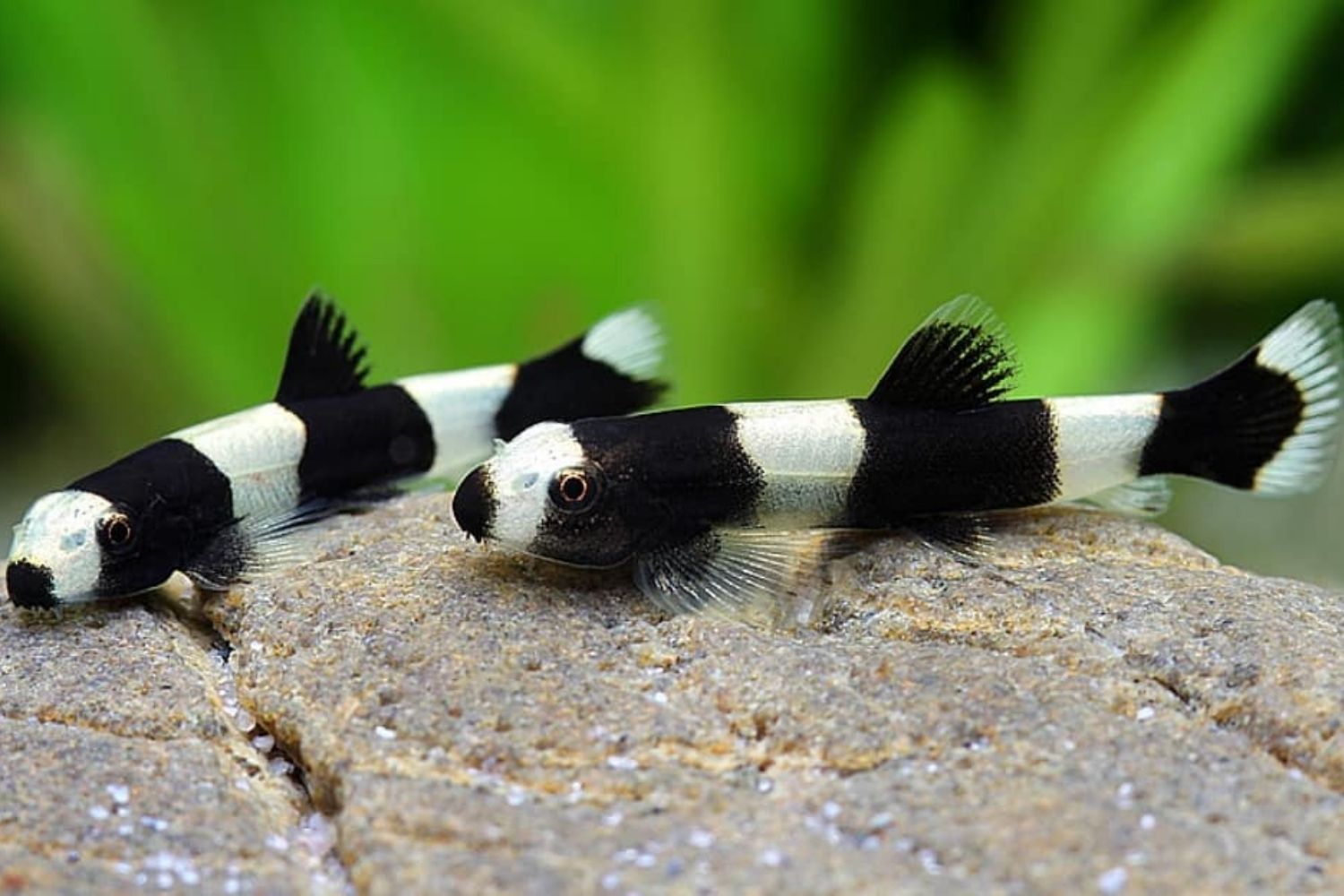Panda Loach (yaoshania pachychilus) are some of the most popular fish for shrimp tanks, and for a good reason – they’re adorable and have attractive markings on their body and fins! These little freshwater loaches can be a bit tricky to care for, but with a few tips, you’ll have them swimming happily in your tank in no time.
In this guide, we’ll go over everything you need to know about keeping Panda Loach healthy and happy in your tank. We will go through Panda Loach size, care lifespan, diet, and more. So whether you’re a first-time aquarist or an experienced hobbyist, read on for all the information you need on panda loaches!
Overview
Panda Loach is also known by its scientific name Protomyzon Pachychilus. This species gained the name Yaoshania from the Dayaoshan mountain where it was discovered. This amazing loach displays black and white stripes when small and black and gold reticulated patterns when grown up.
Panda loaches are a popular choice in the aquarium hobby because they don’t grow too large, and they can be kept in most community tanks. You should be careful while preparing the proper environment and feeding the loach. Therefore, special attention should be given to water requirements.
| Care | Intermediate |
| Diet | Omnivorous |
| Behavior | Peaceful, juveniles solitary, adults exhibit schooling behavior |
| Temperature | 68° – 75° F (20° – 23.9° C) |
| CO2 | A high O2 level is essential |
| pH | 7.0-8.0 |
| dH | up to 25 degrees |
| Lighting | No special requirements |
| Minimum tank size | 20+ gallons (75+ liters) for a small group |
| Maximum size | 3 inches (7.5cm) |
| Average adult size | 2 – 2.4 inches (5 – 6 cm) |
| Average purchase size | 0.3 – 1 inch (0.8 – 2.5 cm) |
| Water environment | Shallow, clear, fast-flowing waters |
Origin & Habitat
This species is subtropical and originates in Southern China, and is distributed in Guangxi. The water in this place is cool, with a fast flow, and also well-oxygenated. It flows over the substrates, mentioning substrates smooth gravel, sand, water-worn rocks, and boulders as well.
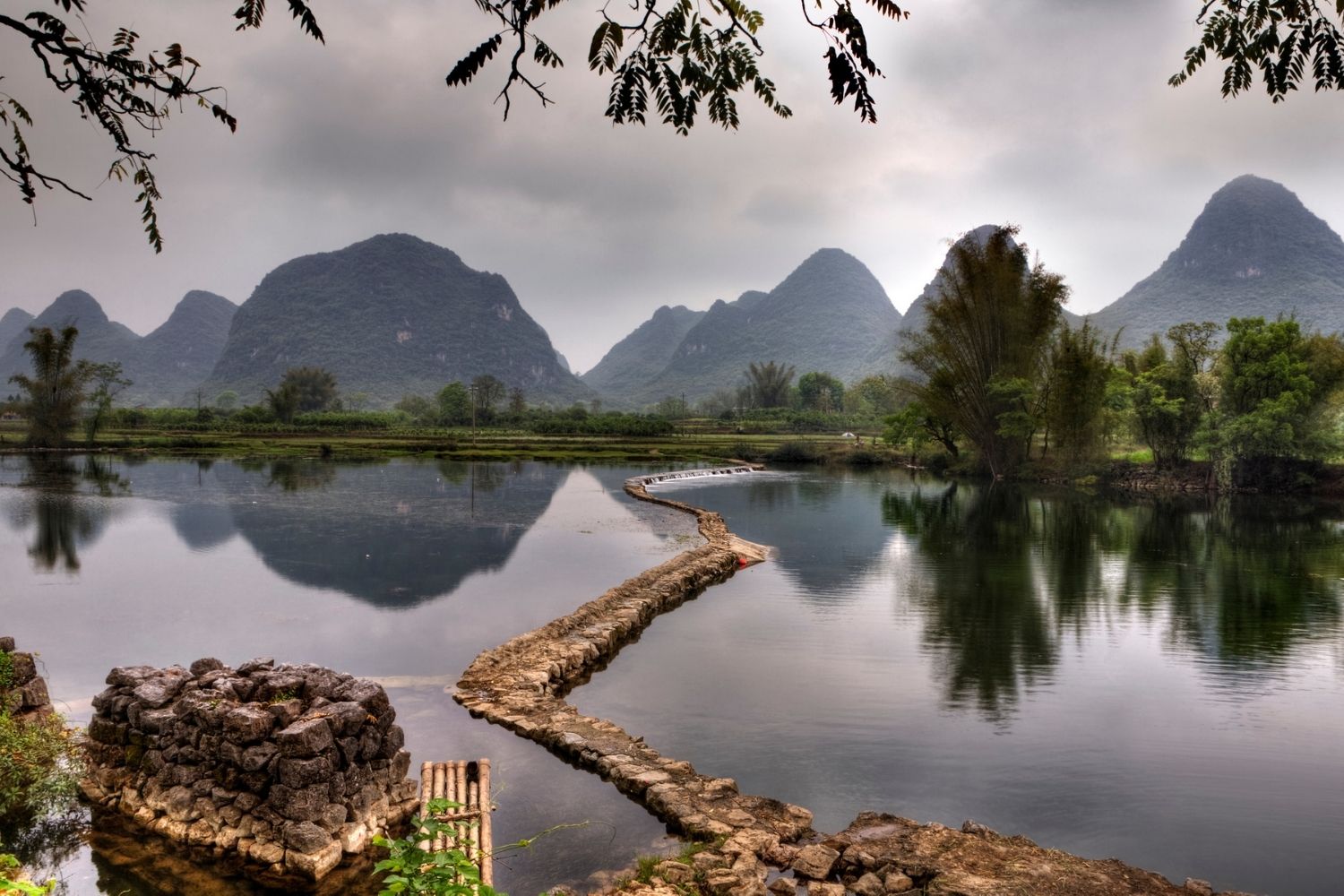
Clear waters of Guangxi – Natural habitat of Panda Loach.
The most favorite habitats of this species are in excess of 500 meters AMSL, where it contains crystalline, oxygen-saturated water that helps and promotes the development of the biofilm layer carpeting submerged surfaces.
The water depth of the Panda Loach habitat is typically 50 cm or less. However, in periods of high rainfall, resulting in increased flow rate and water depth, they may be turbid due to suspended material dislodging.
Appearance and Typical Behavior
The Panda Loach has a creamy-white body with bold black patches and blotches. The Juvenile fish have the boldest pattern in black and white stripes. As the fish grows up and reaches maturity, the pattern changes to a more blotchy, brownish cream coloration and often is characterized by a dark band along the sideway line.

Panda Loach likes to hang on rocks and on plants leaves.
The temperament of this fish is quite tranquil. They are very peaceful. Although juveniles live a solitary lifespan, therefore, when they grow up and become adults, they exhibit schooling behavior.
Panda Loaches are very friendly with other tankmates and get along very well, even with shrimps. An average purchase size may vary from 0.3 – 1 inch (0.8 – 2.5 cm), an average adult size from 2 – 2.4 inches (5 – 6 cm), and reach a maximum size of 3 inches (7.5cm).
There are many reasons to love this fish:
- Panda Loach has a beautiful coloration in both forms, as juvenile and adult.
- It’s peaceful with fish and peaceful invertebrates.
- It has an active social behavior when kept in colonies, quite interesting.
- Dwarf shrimps make an ideal tankmate for this black and white loach.
Food & Diet
Panda Loach feeds on small benthic invertebrates that live in the biofilm and algae graziers in their natural habitat. When in an aquarium, they eat most foods that are offered if they’re of an appropriate size (tiny pieces). If you offer a good variety of fare, for example, mini bloodworm, baby brine shrimp, and daphnia, that would be healthy enough.
Also, a small sinking catfish pellet or even powdered fry foods would be a great choice, especially if your Panda Loach is really tiny. These crushed flakes are also known to accept frozen meaty foods, but foods like this should be fed occasionally only.
This fish will like to eat high-quality dry foods sometimes, but they should be rich in plant matter, but in order to ensure long-term health, they should be fed with biofilm and algae that are naturally available in the aquarium, or else they may slowly starve.
The Panda Loach is a hardy and quite entertaining fish for aquarium enthusiasts, as long as it is kept in a well-maintained, mature aquarium, of course, making sure it has a good biofilm and algae growth, including a high water flow.

A biofilm and algae grazer.
It’s worth mentioning that this fish will not damage the aquarium plants. Therefore, Anubias species are a great plant that can be kept with this loach because they can foster significant biofilm and algae growth in the aquarium with medium to high light and ensure food for the fish. A good alternative is Subwassertang and Bacopa Caroliniana, both foster biofilm in your tank.
Care: Recommended Tank Parameters
Tank parameters are something that you should pay attention to. Here we have the tank size, water parameters, and lightning as required in order to ensure a healthy lifespan for this fish.
Tank Size
When it comes to the tank size, it is recommended to keep at least two Panda Loaches in a tank that has at least 20 gallons of water with plenty of hiding places. The more loaches you have, the larger the tank should be. If you’re planning on breeding them, then you will need an even larger tank.
When first introduced into the home aquarium, they may hide for some time, so be patient. These fish are often found in shoals. Therefore, it is highly recommended to keep them in groups of five or more. This way, you will see how they behave naturally. Otherwise, Panda Loach will be stressed and may even hide all its life.
Water Parameters
Talking about water, it is very important to maintain the proper parameters to take care of this fish. Make sure you maintain the temperature 68° to 75° F (20° to 23.9° C). A higher temperature can be tolerated temporarily but only with extremely high oxygen content.
The alkalinity of the water should also be maintained at a pH level of 6.5 – 7.5. Panda Loach, it is required an aquarium with heavy water flow (10-15x turnover per h). Clear and very clean water is also suggested.
This fish is sensitive to declines in water quality since its natural habitat is in shallow, clear, and heavy flow water. Regular aquarium maintenance and maximum oxygen saturation are an absolute necessity. Therefore, you will need an oxygen pump.
Lighting
This fish does not require lightning specifications, although moderate to high lightning is suggested in order to help the growth of algae and biofilm layer to feed this fish.
Panda Loach Breeding: Tips for Sexing and Breeding
Panda Loach fish is considered to be very hard to breed in the home aquarium. Mature females are more likely to be heavier-bodied compared to males, and if looking forward to sexing, you should keep them in groups of 4+ fish.
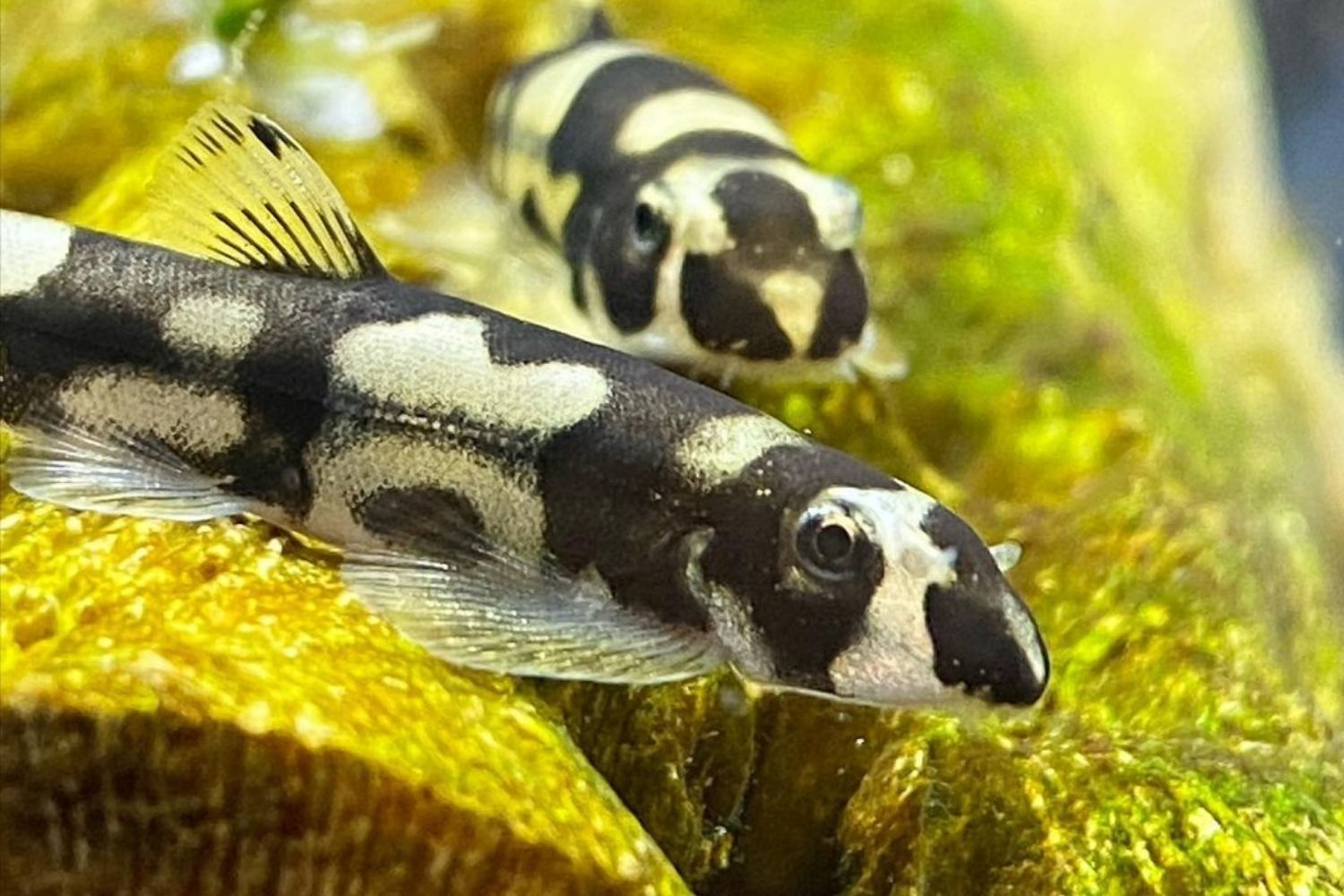
A closer look on Panda Loach.
In aquarium enthusiasts’ experiences, this fish hasn’t been bred in captivity. In order to encourage spawning behavior, it is most important to place a small group of Panda Loach in the proper conditions. If you want to breed this species, you should make some research first, considering their water requirement. In this case, try cool soft water changes with a pH of 7. This will help.
A Common Problem with Panda Loach
If you follow a diet high in protein, it can cause serious health problems to this fish or even death in this species. It is a very delicate species, and it will make a huge mess if feeding more than it should. Schedule their food with an automatic fish feeder to prevent overfeeding.
Tank Mates: What To Put In Their Tank
The Panda Loach is a very friendly fish. It likes to socialize, especially as an adult, so it is suggested to keep in groups. The best tankmates for this fish are:
- Most small tetras, rasboras, hillstream loaches,
- Smaller freshwater goby species
- Peaceful bottom-dwelling fish
- Dwarf shrimp
- Other small, peaceful fish.
Especially with the fish that inhabit similar waterways.
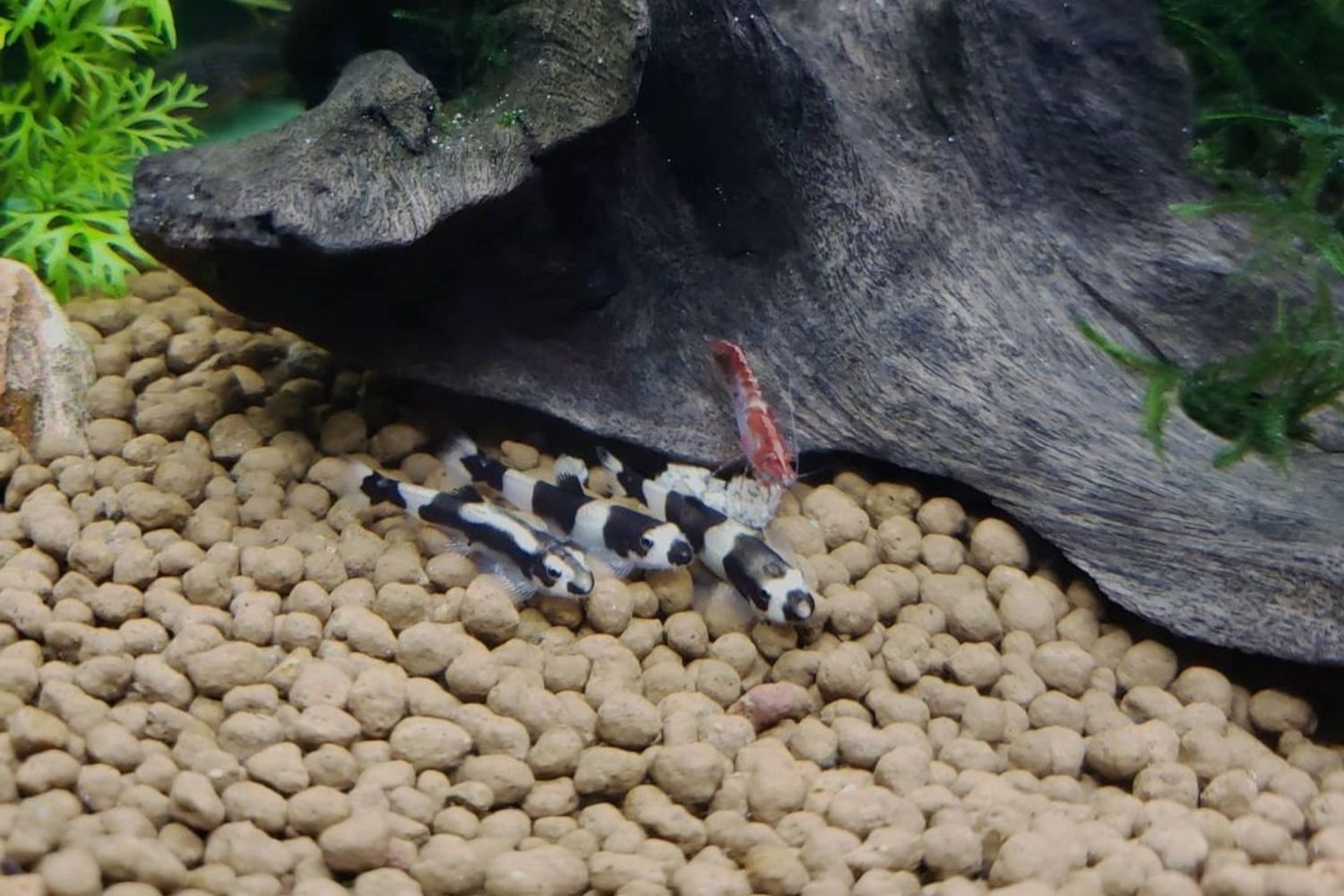
Dwarf Shrimps are good tank mates for Panda Loach
Panda Garra fish is similar to Panda Loach in appearance, behavior, maintenance, diet, and water parameters. Therefore, it is not recommended as a tankmate for this fish since it is bigger in size, not a loach, and might fight it.
Conclusion: Are Panda Loach Suitable for your Aquarium?
Panda Loach has an exceptional coloration in juvenile and adult forms, making this a favorite fish for tank enthusiasts. Its peaceful behavior is another feature that makes this fish suitable for your tank.
Is a very active fish and has a social behavior when kept in colonies. It is safe with dwarf shrimps if fed properly and is friendly with various tankmates, which makes it a favorite choice.
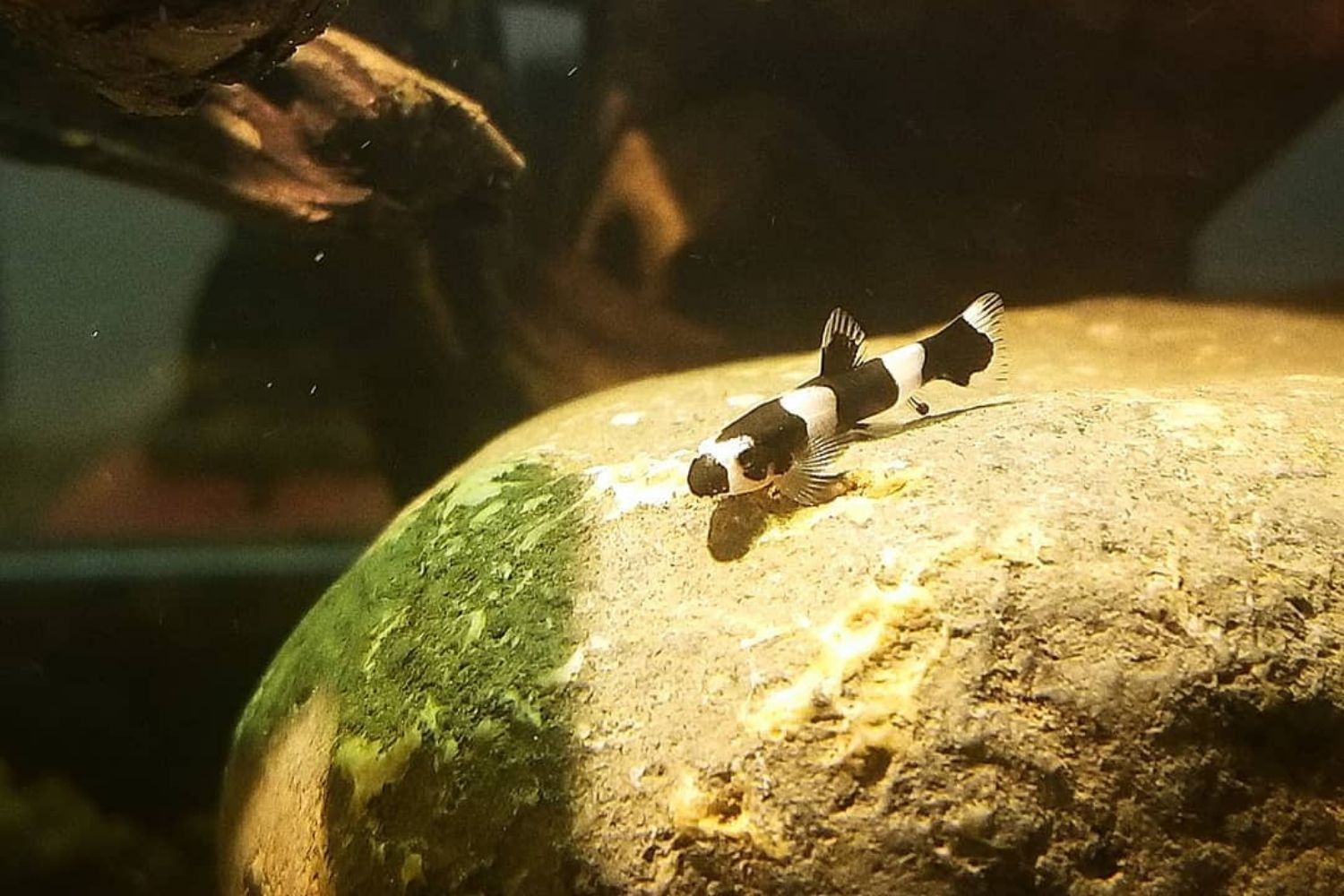
Panda Loach loves to eat algae and hang on rocks.
FAQs
Whether you want to know if Panda Loches can eat snails or shrimps or how big do these freshwater loches get, we have you covered. Here are the answers to those questions and other most frequently asked questions about Panda Loach.
Q: Do Panda Loaches eat snails?
No, Panda Loach won’t eat snails. Therefore, there are kinds of loaches that do so, but Panda Loach species tend to eat tiny pieces of food and are very friendly to snails.
Q: Can you keep Panda Loach in a shrimp tank?
Panda Loach is safe for shrimps and can be kept in a shrimp tank. The tank should be 20 gallons or more and should be fed frequently.
Warning, if there is a lack of food for the Panda Loach, it can eat small fry shrimps.
Q: What does Panda Loach eat?
Panda Loach eats mini bloodworm, baby brine shrimp, Daphnia, frozen meaty foods, biofilm and algae, small sinking catfish pellets, crushed flake, or even powdered fry foods. Generally tiny pieces of food.
Q: How big do Panda Loaches get?
Panda Loaches can reach about 2.5 inches in the wild, but they tend to remain smaller in captivity.
